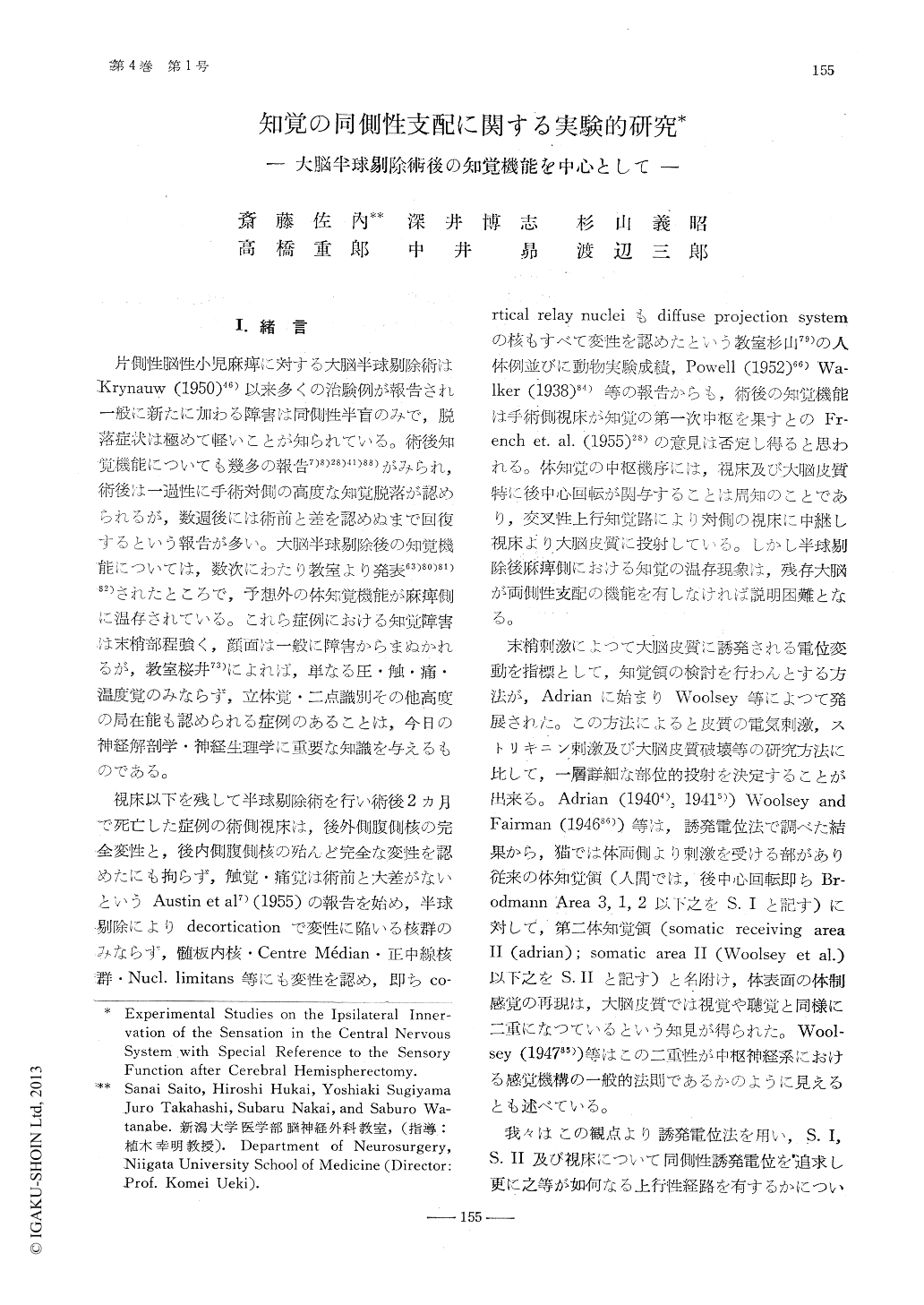Japanese
English
- 有料閲覧
- Abstract 文献概要
- 1ページ目 Look Inside
I.緒言
片側性脳性小児麻痺に対する大脳半球別除術はKrynauw(1950)46)以来多くの治験例が報告され一般に新たに加わる障害は同側性半盲のみで,脱落症状は極めて軽いことが知られている。術後知覚機能についても幾多の報告7)8)28)41)88)がみられ,術後は一過性に手術対側の高度な知覚脱落が認められるが,数週後には術前と差を認めぬまで回復するという報告が多い。大脳半球剔除後の知覚機能については,数次にわたり教室より発表63)80)81)82)されたところで,予想外の体知覚機能が麻痺側に温存されている。これら症例における知覚障害は末梢部程強く,顔面は一般に障害からまぬかれるが,教室桜井73)によれば,単なる圧・触・痛・温度覚のみならず,立体覚・二点識別その他高度の局在能も認められる症例のあることは,今日の神経解剖学・神経生理学に重要な知識を与えるものである。
The considerably remaining somatic sensationnot only protopathic but also epicritic one we-re observed on the contralateral side after sur-gical removal of cerebral hemisphere for infan-tile hemiplegia. In order to solve these problems,experimental studies were carried out by recor-ding on the cortical and thalamic potentials evo-ked by peripheral stimulation before and afterhemispherectomy of the cat. Both tactile stimula-tion on the paw and electrical stimulation onthe superficial radial, saphenous and sciatic ner-ves were used. The afferent spinal pathwaysto the ipsilateral cerebral cortex were studiedby the various sections of the spinal cord. The experimental results are as follows:
A. Before hemispherectomy:
1. The bilateral representation is found insomatic sensory area II localized in gyrus ecto-sylvius anterior with some topographical distri-bution.
2. Author finds out the bilateral representationin the somatic sensory area I which was thou-ght to have mere contralateral representation ofthe superficial and deep sensation except forthe face area.
However, the ipsilateral responses confirmedby author have following characteristics.
a) These ipsilateral responses would be no-ted in both arm and leg areas on the most pr-onounced region of contralateral responses, ho-wever, they are smaller than contralaterally ev-oked one.
b) These are quite peculiar showing longerlatency, smaller amplitude and wave-like outlineas compared with contralateral spike-like appe-arance.
c) These potentials are apt to be influencedby the level of anesthesia more than contralat-eral ones. The former may disappear under deepanesthesia while the latter not. These ipsilateralresponses are suppressed or attenuated duringstimulation is repeated.
3. In the ventral posterolateral nucleus of thethalamus a bilateral somatosensory representationis also confirmed, and ipsilateral responses showlonger latency and smaller amplitude than con-tralateral ones.
B. After hemispherectomy:
The above mentioned ipsilateral cortical evo-ked potentials may have higher amplitude foll-owing hemispherectomy however, several chara-cteristics previously noted can not be changed.
C. Afferent spinal pathway:
Evoked potentials were examined on somaticsensory area I and II before and after spinalcord section of various portions. The resultswould lead author to the opinion that in addi-tion to the dorsal funiculi, crossed and uncross-ed afferent pathways to the thalamus may bepresent in each :side of the lateral column ofthe spinal cord in the cat. The crossed afferentpathway perhaps would relay to the nucleus ce-rvicalis lateralis (Rexed & Brodal 1951) belowCl spinal segment, and reach to the oppositethalamus.
D. Conclusions:
Consequently, author would conclude that af-ter hemispherectomy residual somatic superficialand deep sensation may be mainly controlledby the :somatic sensory I and II of remaininghemisphere via the ipsilateral thalamic sensorypathways.

Copyright © 1959, Igaku-Shoin Ltd. All rights reserved.


